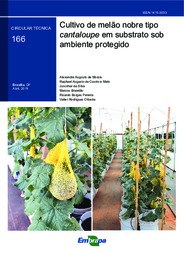The system will enable indoor vegetable production in urban areas. Indoor farms are not impacted by climate or crop seasonality. Rigorous pest control eliminates the need of applying agrochemicals. The technology allows reusing almost all the water applied in the system. This is an ideal solution for cities under water restrictions. A clean production environment eliminates the need of vegetable sanitization. The proximity of the indoor farms to consumer markets reduces losses due to transport and perishability. The activity involves technologies such as environmental sensors, artificial light, and soilless cultivation. A research carried out by Embrapa Vegetables (located in Distrito Federal), in partnership with the 100% Livre retail company of fruits and vegetables, aims to develop systems for the production of different vegetable species in controlled and closed environments, that is, in indoor farming systems, also known as vertical farms and plant factories. A production unit went into operation last November in São Paulo. This model of growing vegetable species in an indoor environment entails cultivation without soil or substrates, artificial light with LED panels, and the control of several meteorological variables within the enclosed structure, including temperature and air relative humidity, net and global radiation, carbon dioxide (CO2) concentration, among others. The experiments, which started this year in April, are being carried out at the Laboratory for Controlled Environment Agriculture at Embrapa Vegetables, in a 90 m2 structure consisting of two coupled and modified containers, which have walls made of thermal panel plates for thermal isolation and are fully equipped with environmental sensors. Worldwide, this model of indoor farming is known as controlled environment agriculture or by its acronym CEA. The main goal of the research is to define production systems for leafy vegetables, such as lettuce and arugula; fruit vegetables, such as tomato, strawberry, and bell pepper; herbs, including basil, coriander, and parsley; and, in a second stage, for sprouts and microgreens. From a market point of view, the choice of the species to be cultivated is an important step in scientific research, since vegetables with a high aggregated value and a shorter production cycle, with several harvests during the year, ensure the economic viability of the enterprise. “Our proposal is to apply scientific knowledge to the physiology of vegetable crops, aiming to modify the indoor environment and maximize production”, explains the coordinator of the project Ítalo Guedes, a researcher at Embrapa in the area of plant nutrition and protected and soilless cultivation. The research will consider productivity both in a single level or layer, known as a plant factory, which is an adequate model for growing fruit vegetables, and in vertical layers, known as a vertical farm, a format more recommended for leafy vegetables and herbs. Concepts used in indoor agriculture Controlled environment agriculture: cultivation in a closed environment in which all environmental factors that affect vegetable growth and production (nutrients, water, temperature, relative humidity, light, air composition) are optimized. Also known as indoor farming. Rooftop farming: cultivation, usually soilless, on the rooftop of buildings such as skyscrapers and malls, using natural light. The vegetables can be cultivated open air or protected. Vertical farming: cultivation of plants in vertical layers with artificial light in each one of them. Bulbs with a lower voltage are usually used. Vertical farming can be done in buildings with only one floor, such as warehouses, or with several floors. The building is called a vertical farm. Plant factory: agriculture in a controlled environment in which the vegetables are grown in a single layer, using artificial light hanging from the ceiling. Bulbs with a greater wattage are usually used. Nutrients via water or vapor Hydroponics: soilless plant cultivation, in which the mineral nutrients that are essential to the plants are dissolved in water, forming a nutrient solution. Aeroponics: soilless plant cultivation, in which the nutrient solution is supplied to the roots as a spray or mist, by passing through foggers or vaporizers. The plant hangs in its support, while the root system is kept in a closed and dark chamber. To evaluate the productive performance of production systems, the research team periodically monitors the cultivated species to follow up on parameters such as: plant height, stalk diameter, total and commercial yield, production per plant, fruit mean weight, or fresh leaf mass. “Agriculture in an indoor environment allows reproducing the ideal climate conditions to cultivate each vegetable species. One of the focuses of our research is to increase productivity, and, for this, layering is important to maximize the use of every square foot”, points out Guedes. Optimizing inputs and production The experiments also allow determining the best soilless cultivation system to be used, by comparing two nutrient and irrigation (fertigation) managements of vegetable crops: hydroponics and aeroponics. The same nutrient solution, with mineral nutrients soluble in water, is used in both techniques but applied in different forms. In hydroponics, the nutrient solution flows through gutters, whereas, in aeroponics, the solution is injected as a mist directly onto the plant roots using a high-pressure vaporizer-type equipment. Hydroponics is a technique known for saving water and nutrients, reducing in up to 90% the use of water and in up to 70% the use of fertilizers, when compared with cultivation directly in the soil in an open field. In relation to hydroponics, aeroponics can save up to 30% water and nutrients, depending on the crop. “Almost 100% of the water is reused” “We are also using dehumidifiers to collect evapotranspiration in the indoor environment, which allows to reuse almost 100% of the water applied in the production system. The water is only not completely reused because part of it is absorbed by the plant, being integrated into its tissue structure”, explains Guedes. Input optimization in indoor agriculture models is an important advantage, especially for large urban areas located in semiarid regions and that face problems related to drought and water scarcity. Vertical farms and other types of controlled-environment agriculture may enable the production of quality vegetables in sites without soil or favorable climate or available water. Preliminary tests with strawberry and some leafy vegetables were promising, but the researchers highlight that developing a production system for indoor agriculture conditions is still a challenge, despite the team’s previous experience with protected cultivation in greenhouses. In comparison with open-field cultivation, for example, several new factors should be taken into account, such as types of LED lamps, differences in the visible electromagnetic spectrum (frequencies ranging from red to violet), time of plant exposure to light (photoperiod), amount of air exchange within the structure, and temperature homogeneity in the environment, among others. “In an analogy with computers, we can say that the containers and their infrastructure function as a hardware, and that we are in the phase of developing the software necessary for the whole system to work. With the experiments, we are able to obtain answers to help us prepare guidelines and techniques for an optimized vegetable production in an indoor environment”, comments the researcher. He adds that: “It is a mistake to think that it is possible to produce without any guidelines, since technology will only show results when accompanied by a compatible production system”. Water, nutrients, light and... action! For a successful vegetable production in an indoor environment, it is necessary to monitor the plants at all times, so that they receive the water and nutrients required for their full development. For example, the nutrient solution is checked every two days, as is water quality and the injection and drainage flows of the nutrient solution. During the first months of the research, the agronomists observed that the plants showed a faster and earlier development within the container, in a completely controlled indoor environment. Initial studies with leafy vegetables, for example, showed a decrease in the production cycle of the plants. Lettuce varieties reached harvest maturity 25 days after the seedlings were transplanted, a period 10 days shorter than that reported under protected cultivation in greenhouses. “Plant precocity is desirable because of its impact in optimizing crop productivity. However, the faster plant development in indoor environments has led to a deficiency in nutrients such as calcium and boron, which cause scorching on leaf margins”, notes the agronomist Juscimar da Silva, a researcher in the area of plant nutrition. According to him, the challenge now is to adjust nutrient availability to the plant, either by increasing its concentration in the nutrient solution or by decreasing fertigation flow times. That is, it is necessary to feed the plants at the right time and with the right amount, to maximize production. According to the research team, this faster plant growth, compared with that of open-field crops, may also be due to the light intensity in the indoor environment. “We found that it is possible to modulate light spectra to induce plant precocity, but, for this adjustment, nutrients and other production-related factors should also been balanced out, for a maximum productive efficiency”, observes Silva. Besides water, nutrients, and light, among the ingredients that are essential for vegetable development, is CO2, a key substance for plants to perform photosynthesis. Therefore, for the development of a vegetable production system in an indoor environment, it is necessary to consider CO2 availability and concentration in the enclosed atmosphere, and the researchers should assess the best way to distribute the gas for the plants to develop well. “In open fields, CO2 is rarely a source of concern since it is one of the main greenhouse gases and has been increasing consistently in the last decades. In an indoor environment, in which air volume substitution is slow or partial, however, the CO2 levels may decrease rapidly, limiting photosynthesis and food production”, ponders Guedes. High quality and no residues The production systems that are being developed by the researchers of Embrapa, in a partnership with the technical team of the 100% Livre company, envision a “business-to-consumer” (B2C) model, in which the vegetables will be sold directly to the end customer, ready to be consumed, without the need of undergoing any sanitization process. Therefore, factors related to food safety and quality are fundamental. Every three days, for example, plant leaves are randomly inspected to detect pests, and, every month, the team collects plant samples from the cultivated area to avoid diseases; in the case of symptoms, the plants are isolated and taken to the laboratory for a precise diagnostics. This periodical monitoring is important because the production systems proposed for the indoor agriculture model, which is physically isolated from the outside world, eliminate the need for pesticide application, ensuring vegetables free of residues and safe for consumption. In addition, the research team aims at defining a protocol for entry and work flow routines, aiming to avoid contamination by any agents from outside the container. The plan for the structure of the vertical farm is based on international standards for quality, such as ISO 22000, which establishes standards for the production of safe foods. The farm structure, for example, includes a antechamber for the decontamination of staff and visitors before entering the production areas, in order to avoid the entry of insects and microorganisms that may be harmful to the vegetables. “Indoor production should follow sanitization and manipulation standards to guarantee clean vegetables, free of pesticides, and without biological contamination”, stresses Guedes, who also lists the quality attributes that will be evaluated, such as appearance, texture, flavor, aroma, and nutritional value. Partnership for innovation The researches on vegetable production in an indoor environment were made viable by a public-private partnership between Embrapa Vegetables and the 100% Livre company, which is already building a vertical farm in the city of São Paulo that should be operational until November of this year. “Our initial plan is to cultivate leafy vegetables and herbs, but, after each research cycle at Embrapa, the idea is to increase our range of action. In the laboratory, the researchers test the technical viability of the vertical farm model in a small scale and, as successful results are obtained, we are able apply the model in a larger scale, for commercial use”, comments Diego Gomes, founder and partner of the company. In his opinion, the greatest advantage of the partnership are the complementing visions, since researches focused on agronomic aspects and studies on the economic viability of indoor production provide a basis for the interaction of the company with its consumers. “Our main goal is to offer practicality and convenience, delivering quality and nutritious vegetables, free of any pesticide or type of contamination, and ready for consumption”, concludes Gomes, pointing out that the vertical farm is not hindered by climate, temperature, or seasonality. Guedes comments that a public-private partnership for this research area is pioneer in Brazil and even worldwide. According to him, although, in Japan, there are several vertical farm initiatives at a commercial scale, powdered especially by the nuclear incident in Fukushima, which contaminated soil and water sources, the producers there follow empirical models because there are no partnerships with universities and research companies. “This is a new enterprise, with little known scientific literature and consolidated knowledge, so each advance in the last few months is a step towards innovation with the seal of Brazilian research”, he celebrates. Other companies have already shown interest in partnerships for researches on indoor agriculture, such as the Israelian company Juganu, which donated a set of high-performance LED lamps to be tested in vegetable production. The results of the first crops in a commercial scale in São Paulo will be used by the company as a parameter for the expansion to other metropolises and capitals of the country, such as Rio de Janeiro. “This is only the first step in developing a model for indoor production, but we are quite optimistic and plan to, in the medium and long term, expand our range of action to other fronts, such as farming of medicinal plants”, envisions Gomes. Foto: Diego Gomes Sustainable cities: come rain or shine! The production of vegetables in open fields, in general, largely depends on ideal climatic conditions to be successful. In Brazil, the predominance of the tropical climate hinders the farming of several vegetable species from regions with a milder and more temperate climate, although this problem is minimized by the efforts of researches in genetic breeding to obtain cultivars more adapted to Brazilian conditions. Considering climate change projections, such as an increased mean temperature or intensity and frequency of rains in some regions of the country, it is a consensus that hubs that traditionally produce vegetables, including green belts, will face difficulties in maintaining their production levels in the next decades, being forced to migrate to areas with more favorable conditions. In indoor agriculture, production is entirely independent of temperature, air humidity, or precipitation conditions. “Over time, the adoption of technologies has been changing the profile of Brazilian agriculture and, because of food insecurity in urban areas due to the distance between production hubs and consumption sites, the models for indoor farming have been gaining space, especially in the case of vegetables, which are a fragile and highly perishable food”, states Guedes. He also highlights that indoor agriculture is only one of the ways of growing vegetables and does not intend to substitute conventional, organic, or greenhouse production. With the aim of optimizing inputs, regenerating underused urban spaces, and eliminating costs with distribution logistics (and fossil fuels), indoor agriculture in metropolises also stands out because it facilitates the access to fresh and quality food. The vegetables produced in a vertical farm can be consumed a few hours or even minutes after being harvested. When the production site is also the retailer and consumer site, it is possible to nullify the high incidence of damaged leaves and fruits and post-harvest losses that can reach up to 50% for some vegetables. The proposal of a model for the production of vegetables that are fresh, nutritious, and readily available to consumers, in large urban areas, is aligned with some of the Sustainable Development Goals of the United Nations, such as Goal 11, which targets more resilient and sustainable cities and communities. However, it is even more aligned with Goal 12 on sustainable production and consumption patterns, targeting the efficient use of natural resources, the reduction of food waste and losses along the production and supply chains, and the reduction of the application of chemical products harmful to the environment and human health. “The focus now is not only on food quantity and quality but also on how this production impacts the environment, natural resources, and the future of our planet. Indoor agriculture is an alternative to make our cities more resilient and sustainable in response to the growing challenges due to resource scarcity, population pressure, and climatic changes”, Guedes points out, while explaining that, in developed countries, urban agriculture represents almost one fourth of vegetable and fruit production. However, in tropical countries, the experiences of growing vegetables in an indoor environment are still scarce, showing the need of scientific research to develop and improve food production systems considering our specificities, with adaptions to reduce production costs and allow offering quality vegetables to a greater proportion of the population.
Photo: Ítalo Guedes

Partnership aims to develop systems for the production of different vegetable species in controlled and closed environments
-
The system will enable indoor vegetable production in urban areas. -
Indoor farms are not impacted by climate or crop seasonality. -
Rigorous pest control eliminates the need of applying agrochemicals. -
The technology allows reusing almost all the water applied in the system. -
This is an ideal solution for cities under water restrictions. -
A clean production environment eliminates the need of vegetable sanitization. -
The proximity of the indoor farms to consumer markets reduces losses due to transport and perishability. -
The activity involves technologies such as environmental sensors, artificial light, and soilless cultivation. |
A research carried out by Embrapa Vegetables (located in Distrito Federal), in partnership with the 100% Livre retail company of fruits and vegetables, aims to develop systems for the production of different vegetable species in controlled and closed environments, that is, in indoor farming systems, also known as vertical farms and plant factories. A production unit went into operation last November in São Paulo.
This model of growing vegetable species in an indoor environment entails cultivation without soil or substrates, artificial light with LED panels, and the control of several meteorological variables within the enclosed structure, including temperature and air relative humidity, net and global radiation, carbon dioxide (CO2) concentration, among others.
The experiments, which started this year in April, are being carried out at the Laboratory for Controlled Environment Agriculture at Embrapa Vegetables, in a 90 m2 structure consisting of two coupled and modified containers, which have walls made of thermal panel plates for thermal isolation and are fully equipped with environmental sensors. Worldwide, this model of indoor farming is known as controlled environment agriculture or by its acronym CEA.
The main goal of the research is to define production systems for leafy vegetables, such as lettuce and arugula; fruit vegetables, such as tomato, strawberry, and bell pepper; herbs, including basil, coriander, and parsley; and, in a second stage, for sprouts and microgreens. From a market point of view, the choice of the species to be cultivated is an important step in scientific research, since vegetables with a high aggregated value and a shorter production cycle, with several harvests during the year, ensure the economic viability of the enterprise.
“Our proposal is to apply scientific knowledge to the physiology of vegetable crops, aiming to modify the indoor environment and maximize production”, explains the coordinator of the project Ítalo Guedes, a researcher at Embrapa in the area of plant nutrition and protected and soilless cultivation. The research will consider productivity both in a single level or layer, known as a plant factory, which is an adequate model for growing fruit vegetables, and in vertical layers, known as a vertical farm, a format more recommended for leafy vegetables and herbs.
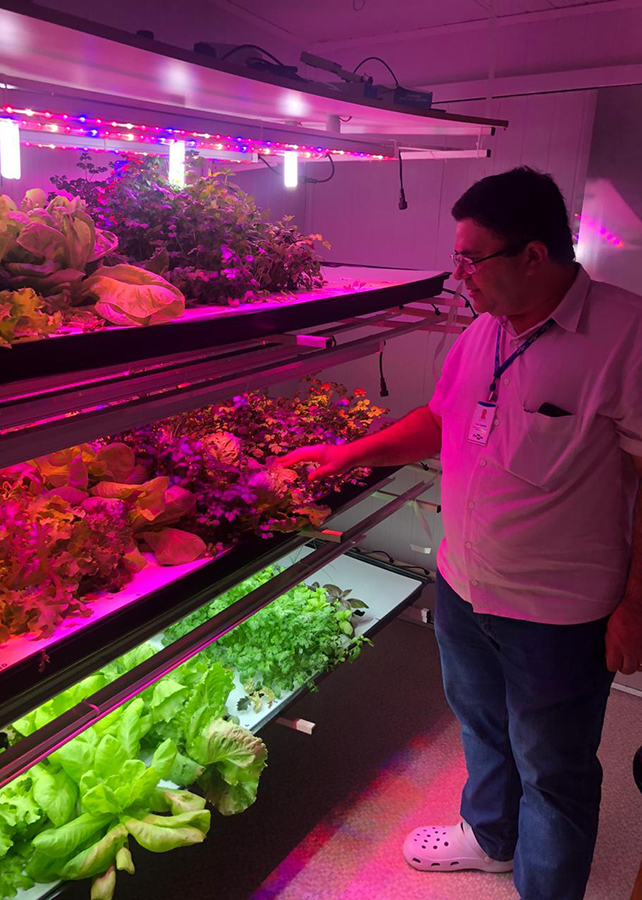 Concepts used in indoor agriculture Concepts used in indoor agriculture
- Controlled environment agriculture: cultivation in a closed environment in which all environmental factors that affect vegetable growth and production (nutrients, water, temperature, relative humidity, light, air composition) are optimized. Also known as indoor farming.
- Rooftop farming: cultivation, usually soilless, on the rooftop of buildings such as skyscrapers and malls, using natural light. The vegetables can be cultivated open air or protected.
- Vertical farming: cultivation of plants in vertical layers with artificial light in each one of them. Bulbs with a lower voltage are usually used. Vertical farming can be done in buildings with only one floor, such as warehouses, or with several floors. The building is called a vertical farm.
- Plant factory: agriculture in a controlled environment in which the vegetables are grown in a single layer, using artificial light hanging from the ceiling. Bulbs with a greater wattage are usually used.
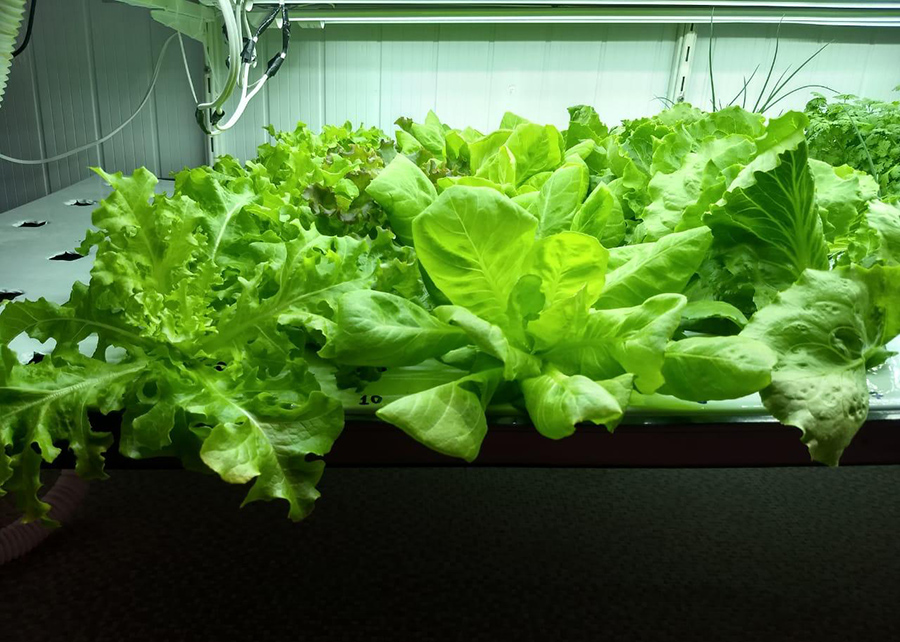 Nutrients via water or vapor Nutrients via water or vapor
- Hydroponics: soilless plant cultivation, in which the mineral nutrients that are essential to the plants are dissolved in water, forming a nutrient solution.
- Aeroponics: soilless plant cultivation, in which the nutrient solution is supplied to the roots as a spray or mist, by passing through foggers or vaporizers. The plant hangs in its support, while the root system is kept in a closed and dark chamber.
|
To evaluate the productive performance of production systems, the research team periodically monitors the cultivated species to follow up on parameters such as: plant height, stalk diameter, total and commercial yield, production per plant, fruit mean weight, or fresh leaf mass. “Agriculture in an indoor environment allows reproducing the ideal climate conditions to cultivate each vegetable species. One of the focuses of our research is to increase productivity, and, for this, layering is important to maximize the use of every square foot”, points out Guedes.
Optimizing inputs and production
The experiments also allow determining the best soilless cultivation system to be used, by comparing two nutrient and irrigation (fertigation) managements of vegetable crops: hydroponics and aeroponics. The same nutrient solution, with mineral nutrients soluble in water, is used in both techniques but applied in different forms. In hydroponics, the nutrient solution flows through gutters, whereas, in aeroponics, the solution is injected as a mist directly onto the plant roots using a high-pressure vaporizer-type equipment.
Hydroponics is a technique known for saving water and nutrients, reducing in up to 90% the use of water and in up to 70% the use of fertilizers, when compared with cultivation directly in the soil in an open field. In relation to hydroponics, aeroponics can save up to 30% water and nutrients, depending on the crop.
| “Almost 100% of the water is reused” |
“We are also using dehumidifiers to collect evapotranspiration in the indoor environment, which allows to reuse almost 100% of the water applied in the production system. The water is only not completely reused because part of it is absorbed by the plant, being integrated into its tissue structure”, explains Guedes.
Input optimization in indoor agriculture models is an important advantage, especially for large urban areas located in semiarid regions and that face problems related to drought and water scarcity. Vertical farms and other types of controlled-environment agriculture may enable the production of quality vegetables in sites without soil or favorable climate or available water.
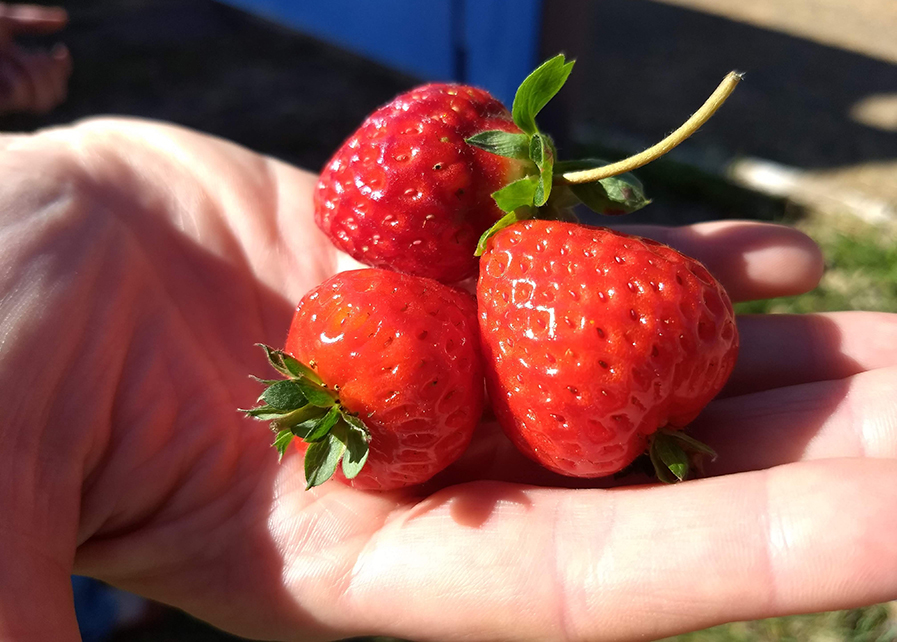
Preliminary tests with strawberry and some leafy vegetables were promising, but the researchers highlight that developing a production system for indoor agriculture conditions is still a challenge, despite the team’s previous experience with protected cultivation in greenhouses.
In comparison with open-field cultivation, for example, several new factors should be taken into account, such as types of LED lamps, differences in the visible electromagnetic spectrum (frequencies ranging from red to violet), time of plant exposure to light (photoperiod), amount of air exchange within the structure, and temperature homogeneity in the environment, among others.
“In an analogy with computers, we can say that the containers and their infrastructure function as a hardware, and that we are in the phase of developing the software necessary for the whole system to work. With the experiments, we are able to obtain answers to help us prepare guidelines and techniques for an optimized vegetable production in an indoor environment”, comments the researcher. He adds that: “It is a mistake to think that it is possible to produce without any guidelines, since technology will only show results when accompanied by a compatible production system”.
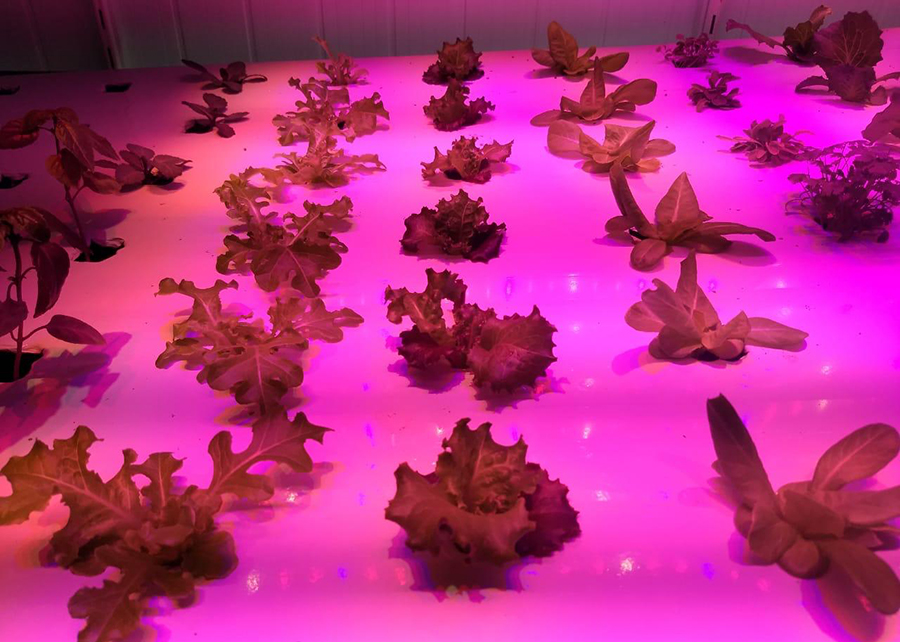
Water, nutrients, light and... action!
For a successful vegetable production in an indoor environment, it is necessary to monitor the plants at all times, so that they receive the water and nutrients required for their full development. For example, the nutrient solution is checked every two days, as is water quality and the injection and drainage flows of the nutrient solution.
During the first months of the research, the agronomists observed that the plants showed a faster and earlier development within the container, in a completely controlled indoor environment. Initial studies with leafy vegetables, for example, showed a decrease in the production cycle of the plants. Lettuce varieties reached harvest maturity 25 days after the seedlings were transplanted, a period 10 days shorter than that reported under protected cultivation in greenhouses.
“Plant precocity is desirable because of its impact in optimizing crop productivity. However, the faster plant development in indoor environments has led to a deficiency in nutrients such as calcium and boron, which cause scorching on leaf margins”, notes the agronomist Juscimar da Silva, a researcher in the area of plant nutrition. According to him, the challenge now is to adjust nutrient availability to the plant, either by increasing its concentration in the nutrient solution or by decreasing fertigation flow times. That is, it is necessary to feed the plants at the right time and with the right amount, to maximize production.
According to the research team, this faster plant growth, compared with that of open-field crops, may also be due to the light intensity in the indoor environment. “We found that it is possible to modulate light spectra to induce plant precocity, but, for this adjustment, nutrients and other production-related factors should also been balanced out, for a maximum productive efficiency”, observes Silva.
Besides water, nutrients, and light, among the ingredients that are essential for vegetable development, is CO2, a key substance for plants to perform photosynthesis. Therefore, for the development of a vegetable production system in an indoor environment, it is necessary to consider CO2 availability and concentration in the enclosed atmosphere, and the researchers should assess the best way to distribute the gas for the plants to develop well.
“In open fields, CO2 is rarely a source of concern since it is one of the main greenhouse gases and has been increasing consistently in the last decades. In an indoor environment, in which air volume substitution is slow or partial, however, the CO2 levels may decrease rapidly, limiting photosynthesis and food production”, ponders Guedes.
High quality and no residues
The production systems that are being developed by the researchers of Embrapa, in a partnership with the technical team of the 100% Livre company, envision a “business-to-consumer” (B2C) model, in which the vegetables will be sold directly to the end customer, ready to be consumed, without the need of undergoing any sanitization process. Therefore, factors related to food safety and quality are fundamental.
Every three days, for example, plant leaves are randomly inspected to detect pests, and, every month, the team collects plant samples from the cultivated area to avoid diseases; in the case of symptoms, the plants are isolated and taken to the laboratory for a precise diagnostics.
This periodical monitoring is important because the production systems proposed for the indoor agriculture model, which is physically isolated from the outside world, eliminate the need for pesticide application, ensuring vegetables free of residues and safe for consumption.
In addition, the research team aims at defining a protocol for entry and work flow routines, aiming to avoid contamination by any agents from outside the container. The plan for the structure of the vertical farm is based on international standards for quality, such as ISO 22000, which establishes standards for the production of safe foods.
The farm structure, for example, includes a antechamber for the decontamination of staff and visitors before entering the production areas, in order to avoid the entry of insects and microorganisms that may be harmful to the vegetables. “Indoor production should follow sanitization and manipulation standards to guarantee clean vegetables, free of pesticides, and without biological contamination”, stresses Guedes, who also lists the quality attributes that will be evaluated, such as appearance, texture, flavor, aroma, and nutritional value.

Partnership for innovation
The researches on vegetable production in an indoor environment were made viable by a public-private partnership between Embrapa Vegetables and the 100% Livre company, which is already building a vertical farm in the city of São Paulo that should be operational until November of this year.
“Our initial plan is to cultivate leafy vegetables and herbs, but, after each research cycle at Embrapa, the idea is to increase our range of action. In the laboratory, the researchers test the technical viability of the vertical farm model in a small scale and, as successful results are obtained, we are able apply the model in a larger scale, for commercial use”, comments Diego Gomes, founder and partner of the company.
In his opinion, the greatest advantage of the partnership are the complementing visions, since researches focused on agronomic aspects and studies on the economic viability of indoor production provide a basis for the interaction of the company with its consumers. “Our main goal is to offer practicality and convenience, delivering quality and nutritious vegetables, free of any pesticide or type of contamination, and ready for consumption”, concludes Gomes, pointing out that the vertical farm is not hindered by climate, temperature, or seasonality.
Guedes comments that a public-private partnership for this research area is pioneer in Brazil and even worldwide. According to him, although, in Japan, there are several vertical farm initiatives at a commercial scale, powdered especially by the nuclear incident in Fukushima, which contaminated soil and water sources, the producers there follow empirical models because there are no partnerships with universities and research companies.
“This is a new enterprise, with little known scientific literature and consolidated knowledge, so each advance in the last few months is a step towards innovation with the seal of Brazilian research”, he celebrates. Other companies have already shown interest in partnerships for researches on indoor agriculture, such as the Israelian company Juganu, which donated a set of high-performance LED lamps to be tested in vegetable production.
The results of the first crops in a commercial scale in São Paulo will be used by the company as a parameter for the expansion to other metropolises and capitals of the country, such as Rio de Janeiro. “This is only the first step in developing a model for indoor production, but we are quite optimistic and plan to, in the medium and long term, expand our range of action to other fronts, such as farming of medicinal plants”, envisions Gomes.
Foto: Diego Gomes
|  Sustainable cities: come rain or shine! Sustainable cities: come rain or shine!
The production of vegetables in open fields, in general, largely depends on ideal climatic conditions to be successful. In Brazil, the predominance of the tropical climate hinders the farming of several vegetable species from regions with a milder and more temperate climate, although this problem is minimized by the efforts of researches in genetic breeding to obtain cultivars more adapted to Brazilian conditions. Considering climate change projections, such as an increased mean temperature or intensity and frequency of rains in some regions of the country, it is a consensus that hubs that traditionally produce vegetables, including green belts, will face difficulties in maintaining their production levels in the next decades, being forced to migrate to areas with more favorable conditions. In indoor agriculture, production is entirely independent of temperature, air humidity, or precipitation conditions. “Over time, the adoption of technologies has been changing the profile of Brazilian agriculture and, because of food insecurity in urban areas due to the distance between production hubs and consumption sites, the models for indoor farming have been gaining space, especially in the case of vegetables, which are a fragile and highly perishable food”, states Guedes. He also highlights that indoor agriculture is only one of the ways of growing vegetables and does not intend to substitute conventional, organic, or greenhouse production. With the aim of optimizing inputs, regenerating underused urban spaces, and eliminating costs with distribution logistics (and fossil fuels), indoor agriculture in metropolises also stands out because it facilitates the access to fresh and quality food. 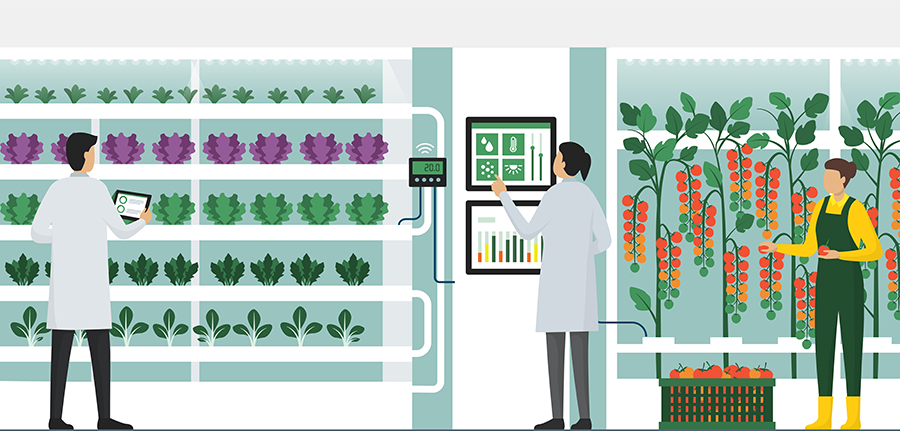
The vegetables produced in a vertical farm can be consumed a few hours or even minutes after being harvested. When the production site is also the retailer and consumer site, it is possible to nullify the high incidence of damaged leaves and fruits and post-harvest losses that can reach up to 50% for some vegetables. The proposal of a model for the production of vegetables that are fresh, nutritious, and readily available to consumers, in large urban areas, is aligned with some of the Sustainable Development Goals of the United Nations, such as Goal 11, which targets more resilient and sustainable cities and communities. However, it is even more aligned with Goal 12 on sustainable production and consumption patterns, targeting the efficient use of natural resources, the reduction of food waste and losses along the production and supply chains, and the reduction of the application of chemical products harmful to the environment and human health. “The focus now is not only on food quantity and quality but also on how this production impacts the environment, natural resources, and the future of our planet. Indoor agriculture is an alternative to make our cities more resilient and sustainable in response to the growing challenges due to resource scarcity, population pressure, and climatic changes”, Guedes points out, while explaining that, in developed countries, urban agriculture represents almost one fourth of vegetable and fruit production. However, in tropical countries, the experiences of growing vegetables in an indoor environment are still scarce, showing the need of scientific research to develop and improve food production systems considering our specificities, with adaptions to reduce production costs and allow offering quality vegetables to a greater proportion of the population. |
Paula Rodrigues (MTb 61.403/SP)
Embrapa Hortaliças
Press inquiries
hortalicas.imprensa@embrapa.br
Phone number: (61) 3385-9109
Further information on the topic
Citizen Attention Service (SAC)
www.embrapa.br/contact-us/sac/


